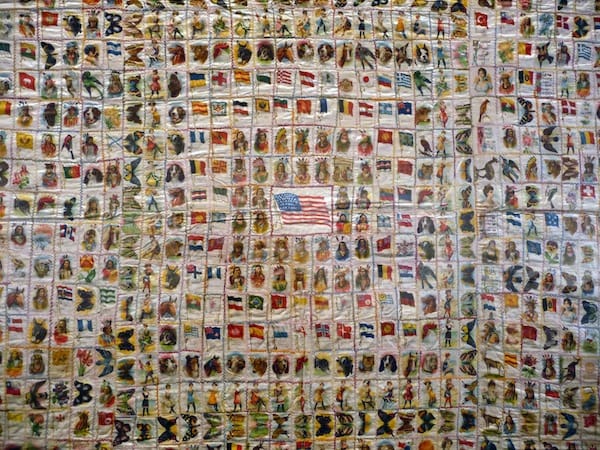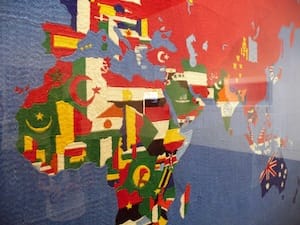Covering Geopolitical Tensions with Bedcovers
LOS ANGELES — Tucked away in a small corner at LACMA is a new show: Common Places: Printing, Embroidery and the Art of Global Mapping. Culled together from the museum's permanent collection, the works consist of embroidery inspired by printed paper works.

LOS ANGELES — Tucked away in a small corner at LACMA is a new show: Common Places: Printing, Embroidery and the Art of Global Mapping. Culled together from the museum’s permanent collection, the works consist of embroidery inspired by printed paper works.
One object, “Bedcover,” is a 1912 work by Mrs. Charles Elwell. It consists of over 600 “silkies” stitched together. The squares’ content represents a United States rising to power, with American Indian leaders and American state flowers on the one hand and foreign flags on the other. All of them surround a giant American flag, which had to be updated with additional stars when Arizona and New Mexico joined the union. Though there’s no sign of Alaska or Hawai’i.

The wall text reads:
“As they bridge the boundaries between paper and textile these objects also blur distinctions between public and private, thus challenging the conception of needlework as inherently domestic and feminine.”
The central work is Mappa, designed by artist Alighiero Boetti in 1979 and hand embroidered by women in Kabul. The map speaks to anxieties of the time, with large red portions representing the flags of Communist countries, as well as a colorful fragmentation of flags in Africa. It’s part of a series from Boetti looking at shifting geopolitical alliances over time.
According to the wall text, Boetti’s work almost didn’t happen. In a way, international crises highlighted the map’s relevance:
“Following the Soviet invasion of Afghanistan in 1979, may of the women fled to refugee camps in Peshawar, Pakistan, and Boetti’s contact with his collaborators diminished.”
The project continued, and all the maps can be viewed in a catalogue at the exhibition space.
Common Places runs till May 13 at the Ahmanson Building at the Los Angeles County Museum of Art ( (5905 Wilshire Blvd, Miracle Mile, Los Angeles).





